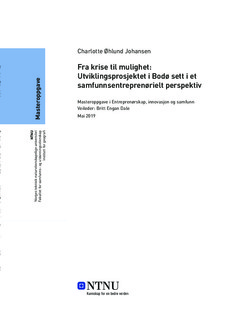| dc.contributor.advisor | Dale, Britt Engan | |
| dc.contributor.author | Johansen, Charlotte Øhlund | |
| dc.date.accessioned | 2019-08-25T14:07:10Z | |
| dc.date.available | 2019-08-25T14:07:10Z | |
| dc.date.issued | 2019 | |
| dc.identifier.uri | http://hdl.handle.net/11250/2610857 | |
| dc.description.abstract | Da beslutningen om å legge ned Bodø hovedflystasjon ble offentliggjort i 2012, ble kommunen satt ovenfor en potensiell krise. Hovedflystasjonen har vært en hjørnestein for byen gjennom 70 år. Nedleggelsen kunne ført til politisk og økonomisk kaos, men i stedet klarte man å snu krise til mulighet gjennom et innovativt og bærekraftig byutviklingsprosjekt.
Denne oppgaven har tre problemstillinger, som er oppdelt i tre analysekapitler. Først, den forsøker å beskrive hva som har skjedd i kjølvannet av vedtaket om nedleggelse av Bodø hovedflystasjon, og hva byutviklingsprosjektet innebærer. Dette innebærer en gjennomgang av sentrale hendelser, rapporter og samarbeidsprosjekter. Kapitlet konkluderte med at Bodø har i stor grad lykkes med å snu krise til mulighet. Denne konklusjonen ble nådd ved å se på utgangspunktet Bodø hadde like i forkant av og like i ettertid av vedtaket om nedleggelse av hovedflystasjonen, og hvordan kommunen i samarbeid med særlig Avinor har kjempet for å skaffe støtte til å bygge en ny sivil lufthavn.
Andre problemstilling tar for seg hvorvidt og hvorfor man kan beskrive Bodø kommune som innovativ. Denne diskusjonen baserer seg på tre kjennetegn ved innovative kommuner: kollektivt entreprenørskap, kobling mellom sfærer og styringsnivå, og særegen diffusjonsprosess. Kapitlet konkluderer med at man kan identifisere en rekke kommunale innovasjoner, i tillegg til andre typer innovasjoner i byutviklingsprosjektet, og at man dermed kan beskrive Bodø kommune som innovativ.
Siste problemstilling tar for seg hvilke samfunnsentreprenørielle egenskaper som kan tillegges prosjektet. Egenskapene er en rekke karakteristikker som kjennetegner samfunnsentreprenørskapsprosjekter. Samfunnsentreprenørskap omhandler entreprenørielle aktiviteter med mål om økonomisk og sosial vekst i et lokalsamfunn. Dette kan innebære å identifisere og vurdere behov i lokalsamfunnet, for så å handle etter de mulighetene som byr seg på en innovativ måte. Oppgaven vurderer hvorvidt disse egenskapene kan relateres til Bodøs byutviklingsprosjekt.
Til slutt tar oppgaven for seg hvorvidt alt har gått på skinner. Kapitlet drøfter to utfordringer: Hayes-saken og Nord Universitet. Diskusjonen rundt disse baserer seg på utsagn fra sentrale personer i prosessen. Man ser her eksempler som viser at store byutviklingsprosjekter ofte møter på utfordrende problemstillinger. Viktigheten med disse er at man finner løsninger som sikrer videre vekst og utvikling, i tillegg til gode samarbeid mellom lokale ressurser. | |
| dc.description.abstract | When the decision to decommission Bodø air force base was announced in 2012, the municipality faced a potential crisis. The air force base has been an economic corner stone for the city. It is easy to imagine both economic and political chaos ensuing, however, in the years following the decision, local politicians and community leaders has been able to turn this looming crisis into a golden opportunity for new and innovative city development.
This paper asks three questions, which is divided into three chapters of analysis. First, the paper attempts to describe what has happened after the decision to decommission Bodø air force base, and describe what the city development project involves. This is done by describing and analysing central events, reports and projects with multiple partners. The chapter concluded that Bodø has succeeded in turning a situation of crisis into an opportunity. This conclusion was reached by comparing the outlook of the situation as the decision was made, and how the commune in cooperation with Avinor and other partners has fought to gain support for a new airport.
The second question analyses how and if one can describe Bodø as innovative. This discussion is based on three characteristics of innovative municipalities: collective entrepreneurship, links between spheres and levels of government, and a distinctive process of diffusion. The chapter concludes that we can identify a number of municipal innovations, in addition to other types of innovations connected to the city development project. In conclusion, Bodø can be described an innovative municipality.
The last question asks whether the city development project has any characteristics related to those of local social entrepreneurship. The type of local social entrepreneurship that is discussed in this paper involves entrepreneurial activities with the intent of economic and social growth in a local community. This involves identifying and analysing needs and acting on these in an innovative way. The paper considers how the case of Bodø is related to these characteristics.
Lastly, the paper discusses two challenges in the city development project. The case of Hayes, and challenges with the local university, Nord Universitet. This discussion is based on statements from central actors in the project. The case made in this chapter is that city development projects such as this often face challenges. The importance in situations such as those describes is finding solutions that secures further growth and development, in addition to successful cooperation among the local resources. | |
| dc.language | nob | |
| dc.publisher | NTNU | |
| dc.title | Fra krise til mulighet: Utviklingsprosjektet i Bodø sett i et samfunnsentreprenørielt perspektiv | |
| dc.type | Master thesis | |
